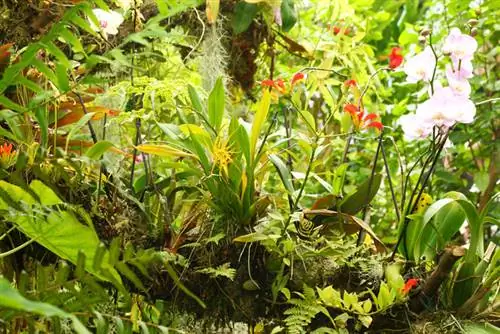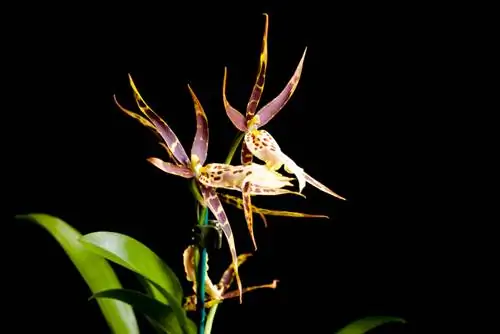- Author admin [email protected].
- Public 2023-12-16 16:46.
- Last modified 2025-06-01 06:02.
White or purple-flowering lilac bushes and trees can be found in many German gardens. What is less known, however, is that there are around 20 to 25 different species of this olive tree plant - most of which are wonderfully suitable as ornamental plants. The different lilacs are native to Europe, but also to Asia.

What types of lilac are there?
Popular lilac varieties are the common lilac (Syringa vulgaris) with numerous subspecies such as 'Andenken an Ludwig Späth' and 'Charles Joly', the Chinese lilac (Syringa x chinensis) and smaller varieties such as Syringa meyeri 'Palibin' and Syringa 'Josee'. These offer different growth forms and flower colors for garden and potted plants.
The most beautiful varieties of common lilac (Syringa vulgaris)
The common lilac has been an extremely popular flowering shrub in our gardens for around five centuries. The multi-stemmed shrub can grow up to seven meters high and spreads through numerous runners. In May, the lilac unfolds its strongly fragrant, blue-violet flowers, which are arranged in ten to 20 centimeter long, multi-flowered panicles. There are also numerous varieties with simple or double flowers. Lilac is suitable for both individual and group planting as well as for lush flowering hedges.
| Variety | Flowers | Growth | Growth height | Growth width |
|---|---|---|---|---|
| ‘Souvenir of Ludwig Späth’ | dark purple, simple | densely branched, bushy | 250 - 350 cm | 150 - 200 cm |
| ‘Charles Joly’ | dark purple-red, purple-white outside, filled | upright, dense, wider at the top | 250 - 350 cm | 125 - 175 cm |
| ‘Katharine Havemeyer’ | purple pink in the bud, later purple, half to double | upright, dense, wider at the top | 400 - 600 cm | 300 - 500 cm |
| ‘Michel Buchner’ | pink purple with white eye, filled | upright, densely branched | 250 - 350 cm | 125 - 175 cm |
| ‘Mme Antoine Buchner’ | soft mauve pink, filled | upright, densely branched | 300 - 500 cm | 200 - 400 cm |
| ‘Mme Lemoine’ | in the bud creamy yellow, blossomed white, double | bushy, upright, densely branched | 250 - 300 cm | 150 - 180 cm |
| ‘Primrose’ | in the bud greenish-yellow, blossomed light yellow, simple | upright, dense, funnel-like | 400 - 600 cm | 300 - 500 cm |
| ‘Sensation’ | purple pink with silver trim, single | strongly upright | 250 - 400 cm | 125 - 175 cm |
Particularly lush blooming: Chinese lilac (Syringa x chinensis)
The Chinese lilac grows loosely upright with thin, arching branches. When it gets old it grows between three and five meters high and just as wide. In May, purple-violet, fragrant flowers appear in large, fairly loose panicles along the branches. The flowers of the 'Saugeana' variety are purple-red. In contrast to many other lilacs, the Chinese lilac is a wonderful solitary shrub with a rich floral bloom due to its pleasing structure. It is occasionally also grown on tall stems. This lilac also feels most comfortable in a sunny and warm location.
More wonderful lilacs for pots and gardens
Syringa meyeri 'Palibin', a compact, delicate and richly branched small shrub that is barely more than a meter high, is perfect for the pot. Even the young plant blooms very profusely in numerous small panicles. The flowers are purplish-pink in bud, eventually whitish-pink when bloomed. The Syringa 'Josee', which grows up to 150 centimeters high, is also suitable for keeping in a container due to its compact growth. Its flowers are violet-purple in bud, but pink when bloomed.
Villosae group lilacs
Common characteristics of the varieties in this group are their height of between three and four meters and their wide, upright growth. The flowers can be purple, pink or white. They grow together in long, narrow and dense panicles and bloom in June. All varieties bloom profusely, are robust and very frost hardy.
Tip
Even if the name suggests otherwise: the buddleia or butterfly lilac is not related to the lilac, but blooms similarly profusely - just later.






